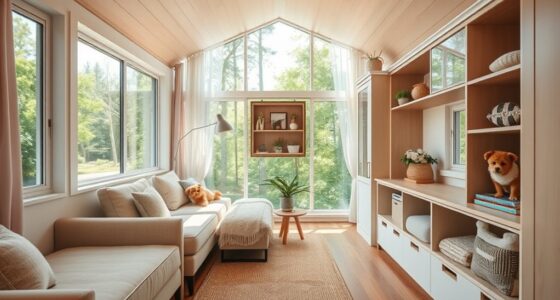Are you prepared to simplify and adopt a more minimalist lifestyle? Come along with us as we delve into the essential steps of downsizing and adapting to life in a tiny house.
From assessing your needs and decluttering personal items to finding clever storage solutions and choosing space-efficient furniture, we’ll guide you through the process.
Get ready to simplify your routines and establish new habits as we address the considerations of living in a tiny house.
Let’s embark on this exciting journey together!
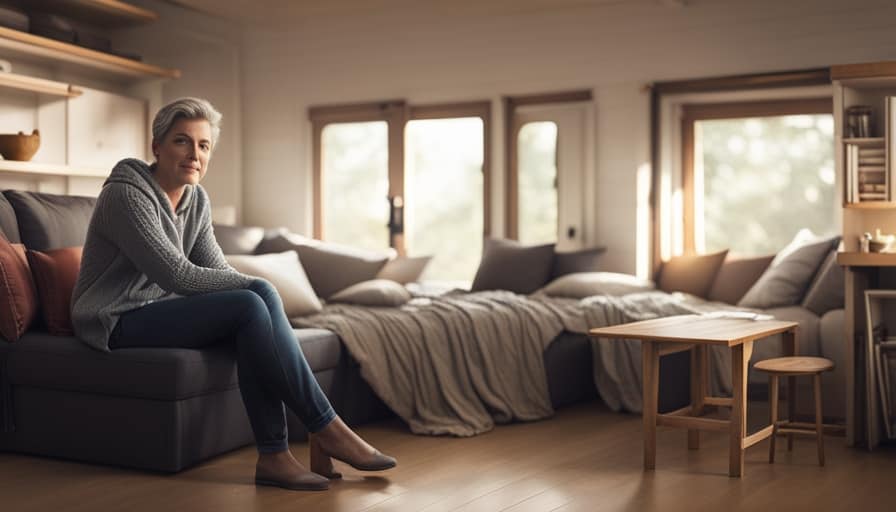
Key Takeaways
- Determine essential items based on space limitations and downsizing strategies
- Prioritize minimalism by sorting and decluttering personal belongings
- Evaluate personal items and determine which ones to let go of
- Organize essentials in downsized living by utilizing storage solutions and maximizing vertical space
Assessing Your Needs and Priorities
First, we should start by identifying our needs and priorities when it comes to living in a tiny house. Assessing space is crucial in determining what we can bring with us and what we need to let go of. Downsizing strategies can help us make the most of the limited space available.
We should consider our daily activities and hobbies to determine what items are essential and what we can live without. Prioritizing functionality and multipurpose items can help maximize the use of space. It’s important to also consider our emotional attachment to possessions and be willing to let go of things that no longer serve us.
By assessing our needs and priorities, we can create a living space that’s both practical and comfortable.
Now, let’s move on to the next step: sorting and decluttering personal items.
Sorting and Decluttering Personal Items
When it comes to downsizing and adjusting to life in a tiny house, one of the key steps is sorting and decluttering personal items. Minimalism becomes essential in small spaces, as we need to prioritize what’s truly necessary and let go of possessions that only take up valuable space.

Minimalism for Small Spaces
As we begin to transition to a tiny house, we need to prioritize minimalism, by sorting and decluttering our personal items. Minimalism isn’t just a design aesthetic; it’s a way of life that allows us to live comfortably in small spaces.
When it comes to sorting and decluttering, it’s essential to be intentional and practical. Start by categorizing your belongings into three piles: keep, donate, and discard. Consider the functionality and necessity of each item. Will it serve a purpose in your new tiny house? If not, it may be time to let go.
Embrace the concept of minimalist decor and choose versatile, multi-purpose furniture and storage solutions.
Letting Go of Possessions
Let’s begin by carefully evaluating our personal items and determining which ones we can let go of in order to adjust to life in a tiny house. Letting go of possessions can be a challenging process, especially when there’s emotional attachment involved. However, it’s essential for creating a clutter-free and functional living space.

Here are some practical steps to help you with the sorting and decluttering process:
- Start with a plan: Create a checklist of categories such as clothing, books, kitchenware, and sentimental items to guide your decluttering journey.
- Assess the usefulness: Evaluate each item and ask yourself if you have used it in the last six months or if it holds any practical value. If not, consider letting it go.
- Consider the emotional attachment: Emotional attachment can make it difficult to let go of certain items. Take time to reflect on the memories associated with them and decide if they’re worth keeping or if a photograph or memento would suffice.
- Donate or sell: Instead of throwing away usable items, consider donating them to those in need or selling them to recoup some of the costs.
Organizing Essentials in Downsized Living
We must carefully and efficiently organize our personal items in order to maximize space and minimize clutter in our downsized living environment. Downsizing presents unique challenges when it comes to sorting and decluttering our belongings.
The first step is to assess each item’s usefulness and sentimental value. Ask yourself if you really need it or if it brings you joy. Be ruthless in your decision-making process.
Next, categorize your items into groups such as clothing, kitchenware, and personal mementos. Use storage solutions that optimize spatial organization, such as collapsible containers, hanging organizers, and under-bed storage bins. Utilize vertical space by installing shelves or using hooks to hang items.
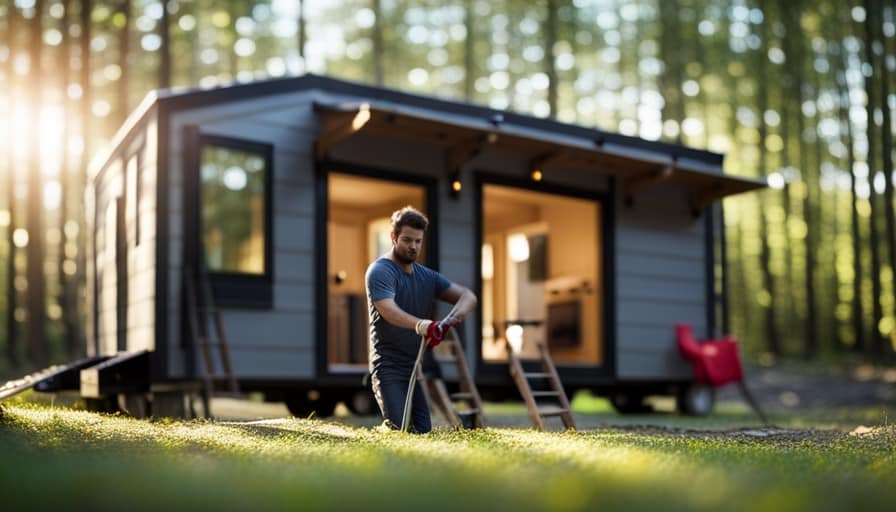
Selling, Donating, or Repurposing Unnecessary Items
We can sell, donate, or repurpose our unnecessary items to make the most of the limited space in our tiny house. Here are some strategies to consider when selling your items:
- Online platforms: Utilize popular websites or apps like eBay, Facebook Marketplace, or Craigslist to reach a wider audience and sell your items quickly.
- Garage sales: Organize a garage sale to sell multiple items at once. Advertise in your community and make sure to price your items competitively.
- Consignment stores: Consider selling high-quality items through consignment stores, where they’ll handle the selling process for you.
- Social media groups: Join local buy and sell groups on social media platforms to connect with potential buyers in your area.
If selling isn’t an option, repurposing can be a great alternative. Here are some creative repurposing ideas:
- Convert old furniture into storage solutions.
- Transform unused containers into planters or organizers.
- Repurpose old clothing into new accessories or home decor.
- Turn empty jars or bottles into decorative vases or candle holders.
Exploring Storage Solutions for Small Spaces
When it comes to storage solutions for small spaces, maximizing vertical storage is key. Utilizing wall space with shelves, hooks, and hanging organizers can help maximize storage capacity without taking up valuable floor space.
Additionally, investing in creative multi-purpose furniture, such as ottomans with hidden storage or beds with built-in drawers, can provide clever storage solutions that blend seamlessly into the tiny house lifestyle.

Maximizing Vertical Storage
As we explore ways to maximize vertical storage in small spaces, it’s important to consider practical and efficient storage solutions. Utilizing the vertical space in your tiny house can greatly increase your storage capacity and help you stay organized. Here are some ideas to make the most of your vertical space:
- Install shelves and compartments on your walls to keep items off the floor and create more storage options.
- Use hanging organizers or hooks to hang items such as pots and pans, utensils, and cleaning supplies.
- Consider investing in furniture that doubles as storage, such as beds with built-in drawers or ottomans with hidden compartments.
- Use vertical storage solutions like stackable bins or baskets to maximize space in closets and cabinets.
Creative Multi-Purpose Furniture
To make the most of limited space, it is essential that we explore creative multi-purpose furniture options that provide storage solutions for small spaces. In a tiny house, every square inch counts, and utilizing furniture that serves multiple functions can significantly maximize the available space. Space-saving design and innovative storage solutions are the key to achieving a clutter-free and organized living area.
Below is a table showcasing different types of multi-purpose furniture and their storage capabilities:
| Furniture Type | Function | Storage Solution |
|---|---|---|
| Sofa bed | Seating and sleeping | Hidden storage underneath |
| Coffee table with storage | Surface area for drinks and snacks | Internal compartments for books, magazines, and remote controls |
| Ottoman with storage | Footrest and extra seating | Inner compartment for blankets, pillows, or shoes |
| Wall-mounted folding desk | Workspace | Shelves or drawers for office supplies |
Choosing Space-Efficient Furniture and Multi-functional Pieces
Our main goal when choosing space-efficient furniture and multi-functional pieces is to maximize the limited space available in our tiny house.
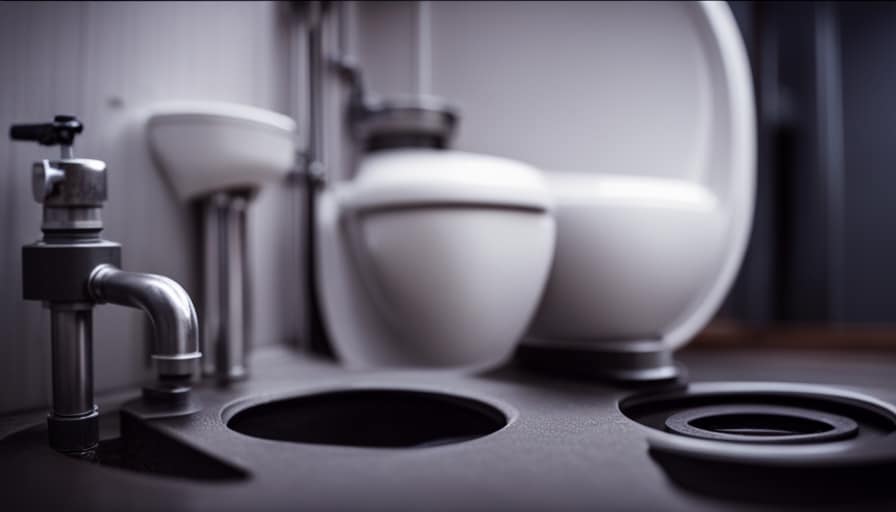
To achieve this, we can consider the following space-saving hacks and strategies:
-
Folding furniture: Opt for items like folding tables and chairs that can be easily stored away when not in use, freeing up valuable floor space.
-
Wall-mounted storage: Install shelves, hooks, and racks on the walls to utilize vertical space and keep items organized and easily accessible.
-
Multi-purpose furniture: Invest in furniture that serves multiple functions, such as a sofa that can be converted into a bed or storage ottomans that can also be used as seating.

-
Built-in storage: Incorporate built-in storage solutions like under-bed drawers, built-in closets, and hidden compartments to maximize storage space while keeping things neat and tidy.
Simplifying Daily Routines and Establishing New Habits
We can streamline our daily routines by incorporating simple and efficient habits into our lifestyle in a tiny house. When living in a small space, it’s important to establish new routines that simplify tasks and make our lives easier.
One way to do this is by creating a daily schedule and sticking to it. This helps us stay organized and ensures that we have enough time for all our activities.
Additionally, we can simplify tasks by decluttering regularly and keeping only the essentials. This not only saves space but also reduces the time and effort required to clean and maintain our tiny house.
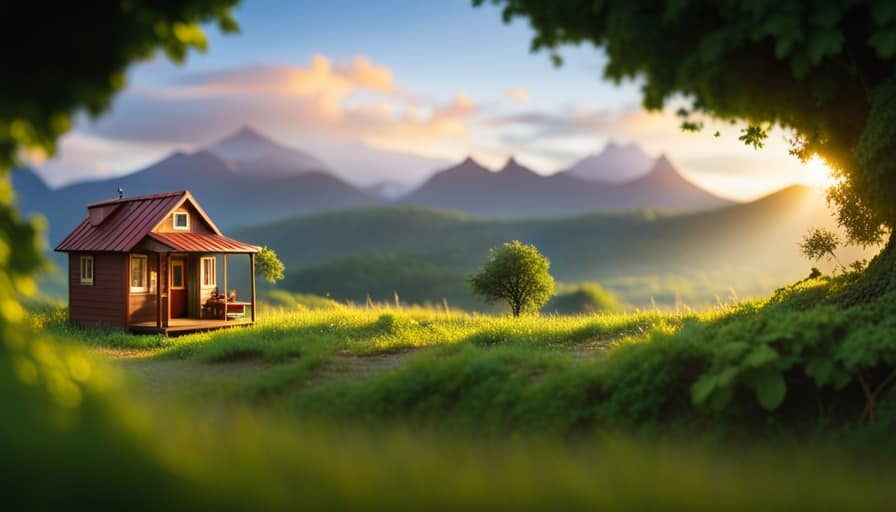
Another tip is to invest in storage solutions that maximize space and keep everything in its place.
Addressing Other Considerations for Living in a Tiny House
Although living in a tiny house presents unique challenges, there are several other considerations that we must address to ensure a comfortable and fulfilling lifestyle.
Here are some important factors to keep in mind when living in a tiny house:
-
Living sustainably: Embrace a more environmentally friendly lifestyle by reducing waste, conserving energy, and utilizing renewable resources. Install solar panels, compost organic waste, and use eco-friendly materials in your tiny house to minimize your carbon footprint.

-
Budgeting for a tiny house: Create a realistic budget that takes into account not just the cost of building or buying a tiny house, but also ongoing expenses such as utilities, maintenance, and insurance. Prioritize your spending and find creative ways to save money, such as growing your own food or finding second-hand furniture.
-
Maximizing storage: With limited space, it’s crucial to make the most of every inch. Invest in clever storage solutions like hidden compartments, built-in shelves, and multi-purpose furniture to keep your tiny house organized and clutter-free.
-
Considering zoning and legal requirements: Before settling down in your tiny house, research local zoning regulations and legal requirements. Make sure your tiny house is compliant with building codes and obtain any necessary permits or approvals to avoid potential legal issues.
Frequently Asked Questions
How Do I Handle the Emotional Attachment to My Personal Items When Sorting and Decluttering for a Tiny House?
When sorting and decluttering for a tiny house, we understand the emotional attachment to personal items. To handle these emotions, we recommend using downsizing techniques like Marie Kondo’s method and seeking support from loved ones.

Are There Any Specific Strategies for Selling or Repurposing Items That Are Too Valuable to Simply Donate?
When it comes to selling or repurposing valuable items in a tiny house, we’ve found that researching online marketplaces, hosting a garage sale, or repurposing items creatively can be effective strategies. Additionally, organizing sentimental items into a designated space can help maintain their importance.
What Are Some Creative Storage Solutions for Small Spaces That May Not Be Mentioned in the Article?
When it comes to creative storage solutions for small spaces, we’ve found that maximizing vertical space is key. By using wall-mounted shelves, hanging organizers, and stackable containers, we can make the most of every inch in our tiny house.
How Can I Ensure That the Furniture I Choose for My Tiny House Is Both Space-Efficient and Comfortable?
To ensure space-efficient and comfortable furniture for our tiny house, we researched space saving furniture options, focusing on multi-purpose pieces and compact designs. We prioritized maximizing comfort in small spaces by considering ergonomic features and customizable options.
Are There Any Tips for Adjusting to a Simpler Daily Routine and Establishing New Habits in a Tiny House?
Adjusting to minimalism and developing a routine in a tiny house can be challenging, but with a few key steps, it becomes manageable. Prioritizing organization, embracing simplicity, and creating new habits are crucial for a successful transition.
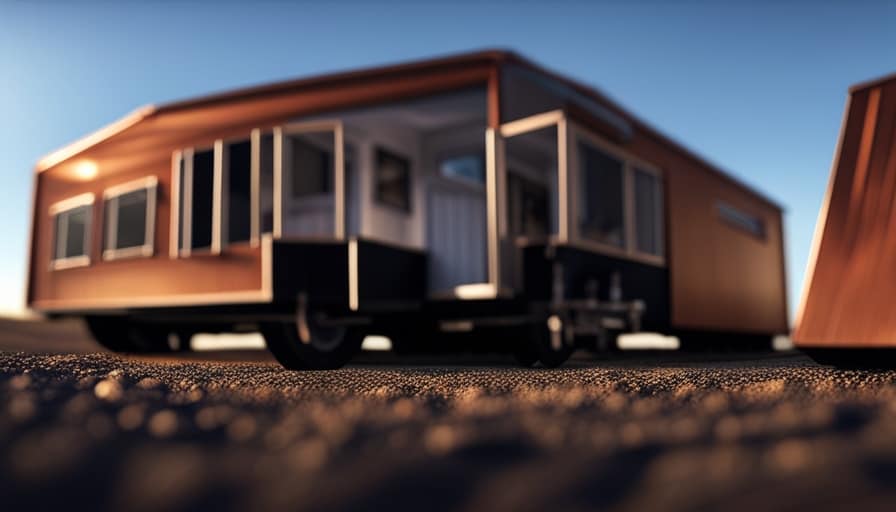
Conclusion
In conclusion, downsizing and adjusting to life in a tiny house can be a challenging but rewarding experience. By assessing our needs and priorities, sorting and decluttering our personal items, and exploring storage solutions, we can create a space that’s both functional and comfortable.
Choosing space-efficient furniture and simplifying daily routines will further maximize the use of our limited space. With a little creativity and a willingness to embrace a simpler lifestyle, living in a tiny house can offer a cozy and fulfilling home.
I’m Theodore, and I love tiny houses. In fact, I’m the author of Tiny House 43, a book about tiny houses that are also tree houses. I think they’re magical places where imaginations can run wild and adventures are just waiting to happen.
While tree houses are often associated with childhood, they can be the perfect adult retreat. They offer a cozy space to relax and unwind, surrounded by nature. And since they’re typically built on stilts or raised platforms, they offer stunning views that traditional homes simply can’t match.
If you’re looking for a unique and romantic getaway, a tree house tiny house might just be the perfect option.






